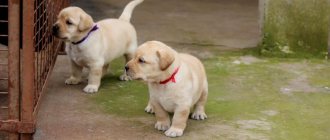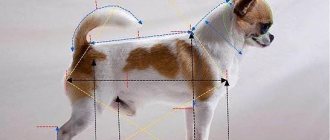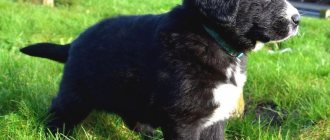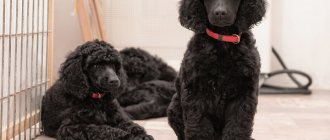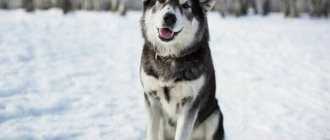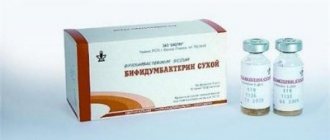Labrador retriever puppy age. When is the best time to take it?
According to the rules of the RKF (Russian Cynological Federation), puppies receive documents from 45 days. Starting at this age, they are ready to move to their owners.
What age is best to adopt a Labrador puppy is a question that is asked quite often. First of all, let's figure out who is better for - for the puppy or for the owners?
Physiologically, from the age of 35 days, the puppy is able to feed independently and not depend on the mother. But taking such a small puppy is not only wrong, but also criminal. After all, this disrupts his natural psychological development and socialization.
Based on the psychological maturity of the puppy, the best weaning age is 7 weeks. By this age, the period of socialization in dog society ends.
To quote D. Fisher, “The main function of this period of socialization in dogs is for the puppy to learn how to regulate his bite force, communicate with other dogs, establish a hierarchy, and, also vitally important, he comes into contact with a person. Breeders should regularly pick up puppies, gently turn them over, check eyes, ears, teeth, paws, etc. By doing this, they not only give the puppies a pleasant human experience, they also expose the puppies to mild stress, which will help them build resilience to stress later on. Puppies that are given the opportunity to complete this period in the company of their mother and other puppies, constantly feeling warm and protected, and, in addition, gain experience in contact with people, usually grow up to become well-adjusted adult dogs.”
E. N. Mychko identifies the following stages of development - up to 8 weeks, the imprinting period. The puppy remembers the image of its species, the person, and is maximally open to the world around it. The social concept “WE” is being formed. This first period coincides with the stage of individuality formation; it occurs between the ages of 6 weeks and 5 months. The puppy becomes aware of its own “I”. His research activity and independence are increasing.
It turns out that the best age for a puppy to change its place of residence is 8-9 weeks. It is better to take a puppy at this age, since it will be easier for him to get used to new circumstances and will be “tied” to the owner more than an older puppy.
What's best for the owners? It's individual. Everyone has different capabilities. Of course, raising your dog from a 45-day-old “baby” is a great joy and happiness. A small Labrador puppy easily gets used to a new environment, quickly learns its social status and, importantly, sleeps a lot. As they grow older, their periods of wakefulness become longer, so the older the puppy, the more attention they require. You also need to take into account that a puppy of this age needs 4-5 feedings a day and regular communication with people. If the baby is left alone during the working day, you should think about purchasing a grown-up puppy - from 3 months. At this age, 3 feedings a day are sufficient. And the foundations of education and social relations will already be laid by the breeder. But here you need to take into account that breeders are different, and the conditions in which the puppy will grow up will certainly be reflected in its character. By 5 months, the puppy is already a fully formed personality, with its own individual traits and habits that can be adjusted, but not changed. Therefore, when you decide to get a Labrador Retriever puppy, first of all, look for a good breeder!
Benefits of a raised puppy
1. A grown-up puppy is easier to live with, you can feed it 3 times a day (not 5, like a baby), you can start training seriously, it is difficult for children to accidentally injure the puppy while playing. 2. All vaccinations and dewormings have been completed. 3. Certain skills have been developed (the puppy knows how to walk on a leash, tries to go to the toilet outside). 4. Mental characteristics are visible (communication skills, reaction to stress, learning ability). The character has already been determined (a small puppy is always a surprise). 5. The exhibition potential and exterior of the dog are visible, including all defects, if any: cryptorchidism in males, malocclusion, pathologies of joint development (dysplasia). When purchasing a small puppy, we acquire along with it all the “growth” risks. Risks of improper formation of bite, muscles and skeleton, childhood diseases and injuries. The risks of improper socialization of a puppy (especially in unprofessional hands) are also higher than for a teenager with an already formed good character
Source
About age criteria for acquisition
When starting to choose a pet, you need to find out not only at what age it is better to adopt a puppy, but also what its weight and other characteristics should be.
Weight Features
At birth, the height of a small puppy, for example, a Chihuahua, ranges from 400 to 800 g. The gender and number of dogs in the litter also matter. With all this, it is always worth considering that males appear larger.
Age 45 days
Buying a pet when it reaches 45 days of age is a more applicable option. By this age, the breeder already has all the necessary documents in hand. In addition, the dogs are already vaccinated and can eat without outside help. The downside is that it is difficult to find the protective properties of a puppy, but obviously shy and unsure of their own abilities individuals are already visible.
Up to a month
If you purchase a puppy under 1 month of age, its price will be much cheaper. The thing is that the breeder has not yet had time to spend significantly on feeding, and there will be much more dogs to choose from. But when buying a pet at this age, there is a tangible disadvantage: the baby needs his mother, he has a weak immune system, and finding a temperament in the first month of life is unrealistic.
The right choice of puppy for a home depends on its age.
Is it possible to adopt a puppy older than 3-4 months?
According to the generally accepted view, the older the dog, the more difficult it is for it to get used to a new family and area. But this is not entirely true: dogs over 3-4 months old can already give a signal that they need to relieve themselves. They already understand a number of commands and everything else, they have a stable digestive system. But such a pet has already formed the disposition and habits that will need to be accepted.
It will be easier for the owner to cope with the puppy at a young age. And all because a small dog needs attention and often a person has to actually replace his mother. But it is worth considering that small breeds, for example, pug, dachshund, mature faster, but large ones, like Labrador, mature later.
How to choose a Labrador, what to look for, what documents the dog should have.
Fundamentally! Often, breeders later put up for sale dogs that are the best in the litter, so taking a dog older than 3-4 months is acceptable.
Osteochondrosis
This is a severe pathology, accompanied by joint damage and cartilage degeneration. It occurs in dogs of different ages and leads to irreversible consequences. Most often it affects the hock, knee, elbow and shoulder joints. But sometimes the pathology spreads to the spine.
Osteochondrosis develops gradually. In the initial stages, the dog is reluctant to stand up and moves carefully after getting up. In some cases, the four-legged patient experiences an increase in the affected joints. The animal experiences severe pain and rarely changes body position. In severe cases, the dog loses control of the limbs but retains sensation.
This pathology begins to develop as a result of injury, excess weight, hypothermia, increased physical activity, excess calcium and rapid weight gain with insufficient bone strength. In addition to all the above reasons, Labradors have a breed predisposition to osteochondrosis. Heredity affects the degree of development of capillaries located around the joints and the elasticity of cartilage tissue.
Treatment of osteochondrosis should be carried out by an experienced veterinarian who can correctly assess the condition of the animal and the degree of damage. Therapy for this pathology is aimed at eliminating inflammation, restoring cartilage tissue and reducing pain. For this, four-legged patients are prescribed a special diet that involves minimizing calcium intake and increasing foods containing zinc, manganese, omega-3 and omega-6 unsaturated acids.
To stop attacks of pain, the dog is prescribed non-steroidal anti-inflammatory drugs, first in injections, and after a couple of days - in tablets. To improve the condition of the cartilage, the dog is given ascorbic acid and B vitamins. For the same reasons, he is prescribed complexes that contain glucosamine and chondroitin.
Good results can be achieved using hormonal drugs, massage and darsonvalization. Osteochondrosis can be successfully cured in the initial stages. Therefore, if you notice the first symptoms, such as a slight limp or stiffness of movement, immediately make an appointment with an experienced veterinarian.
What to look for when choosing a puppy
To choose a Labrador puppy wisely, you need to determine why you are getting him. Depending on their characteristics, dogs are divided into several classes:
- Pet class - puppies that have deviations from the standard that do not allow them to participate in exhibitions and breeding. However, they make good pets. Girls are usually sterilized to eliminate the need to care for unwanted offspring.
- Breed class - Labradors with excellent pedigrees, but minor defects in appearance. If you choose the right partner, such a dog will give good offspring.
- Show class – the best puppies with excellent show prospects. They have almost perfect anatomy and temperament. Their parents are high-quality producers, champions of various exhibitions.
For your information. There are no perfect Labradors. Each individual will have disadvantages, which are assessed depending on their severity, impact on health and performance characteristics.The higher the class, the more expensive the puppy. For pets they ask about 15-25 thousand rubles, and for first-class show dogs - 50-60 thousand rubles. The low price should alert you - no one will sell an excellent specimen for a very modest amount.
Pedigree of the puppy
Pedigree is a guarantee of purebred dog. This document contains information about the puppy's ancestors up to the third generation inclusive. It confirms not the quality, but the origin of the dog. This point is no less important - it also allows you to make the right choice.
Small puppies do not have a pedigree - they are issued at approximately 15 months (after 15 months they are registered for exhibitions only by pedigree). Until this moment, the baby’s breed is confirmed by metrics. It should contain the following information:
- breed;
- floor;
- color;
- Date of Birth;
- stamp number;
- information about the breeder/kennel;
- parents' data (nicknames and pedigree numbers).
puppy's name;
Dysplasia
This is a common and quite serious joint disease. It is becoming more common in Labrador dogs. Therefore, before using an animal for breeding, it is advisable to take x-rays of it. According to experts, this pathology develops under the influence of several different factors. It can be triggered by genetics, excess weight, an unbalanced diet, high levels of calcium and phosphorus, excessive exercise or limb injuries.
This paw disease in Labradors is accompanied by limping and swaying when walking, swelling or swelling of the joints. Symptoms characteristic of dysplasia also include pain in the elbows or hips, body asymmetry, unusual lying posture, stiffness of movement and fatigue.
This pathology can be diagnosed through radiography, but the only way to get rid of it is through surgery. To alleviate the condition, a sick dog is usually prescribed maintenance therapy, which includes a whole range of medications. As a rule, veterinarians prescribe chondroprotectors, antispasmodics and anti-inflammatory drugs to four-legged patients.
Girl or boy?
Both girls and boys make excellent companions. However, the character and representatives of different sexes have their own characteristics, which should be taken into account when choosing.
Boys are usually bred for show careers, hunting or search and rescue. They do not go into heat, have no forced breaks for pregnancy and caring for their offspring.
However, males have a more obstinate disposition - it will be more difficult for novice dog owners to cope with them. When meeting a female in heat, boys lose their composure and can run away after the “lady” they like.
Girls are usually more flexible. They have a developed maternal instinct, so they become excellent nannies for their master's children. Thanks to their calm nature, they are easier to train - they do not strive to take a leadership position and obey all family members.
The owner of the girl will have to come to terms with regular estrus, which occurs twice a year. And although Labradors are very clean, during this period the female may accidentally stain furniture or things.
To avoid unwanted pregnancy, during heat the dog will have to be kept on a leash during walks and pushy suitors will have to be driven away from it. If the owner decides to have offspring, he will need to find a worthy “groom”.
For your information. During pregnancy and after childbirth, females need special care, which requires some experience and skills.
It should be remembered that every dog is individual. Among boys there are calm and gentle individuals, and among girls there are cocky and wayward ones. Therefore, it is simply impossible to answer unequivocally in favor of whom to choose.
Appearance of the dog
To choose the right pet, you should study the breed standard. Then it will become clear what an ideal Labrador looks like. Of course, the puppies are still too small, so assessing their exterior is quite difficult.
When choosing, first of all pay attention to the following signs:
By 2 months puppy labrador usually weighs 7-8 kg, and its height at the withers is 30-33 cm. Minor deviations up or down are acceptable, depending on the individual characteristics of the baby. You should not choose dogs that are clearly lagging behind in development or that are significantly ahead of their relatives.
If a person chooses a Labrador puppy for the first time, it is advisable to invite a dog handler who is familiar with this breed to inspect the litter.
To make the right choice, you need to make sure the puppy is healthy. In normal condition the baby:
- clean eyes and ears;
a well-formed skeleton without dislocations or improperly fused bones;
In Labrador Retriever nurseries, puppies must be kept in a spacious and clean enclosure and receive balanced, high-quality food.
Important. Labradors are susceptible to hip dysplasia. Therefore, before making a choice, it is recommended to familiarize yourself with x-rays of the puppy’s parents’ limbs.
Conservatism won
The British were the first to recognize the Labrador Retriever breed. They also defined the first standard, which was refined several times. Today the description made in 1988 by the English Kennel Club is relevant. Six years after this, American dog breeders also set their standards. Later descriptions of breed qualities partially absorbed earlier ones.
In fact, evolution happens all the time with all standards. Indeed, in the process of development, a dog of any species acquires some new qualities or may lose those that become unnecessary. Accordingly, previously recognized standards are changing.
Continuing the comparison, you can notice that in all descriptions the dog has a wide skull, powerful loin and croup. However, Americans emphasize unwanted fleshiness on the scalp, considering it a drawback.
Until 1993, according to their standard, it was considered acceptable for a Labrador to have a level bite. This is currently unacceptable. The bite should only be scissor-shaped, that is, the upper incisors must tightly overlap the lower ones. It turns out that the conservative English view still prevailed.
How to choose the right Labrador puppy
If the future owner has chosen a Labrador retriever, there is no need to rush into the purchase. First, you should study information about the breed, visit exhibitions, and communicate with breeders and current owners. This is the only way to get a complete picture of these dogs and make the right choice of a puppy so as not to be disappointed in the future.
Puppy breeder
Dog handlers recommend buying puppies from trusted nurseries that are part of the RKF structure. Of course, Labradors are sold both at poultry markets and on the Internet, where there are many advertisements for dogs for sale. But such kids usually do not have documents - no one guarantees their breed and health.
Only a purebred puppy will have the qualities inherent in Labradors - excellent instincts, devotion, intelligence, insight and obedience.
Important. In large nurseries, babies are booked several months in advance.
Large nurseries value their reputation, so they approach raising puppies responsibly.
A conscientious breeder loves his charges, keeps them in excellent conditions and is happy to talk about each dog - he is the one who will help you make the right choice. These people spend a lot of money and effort on caring for their dogs - maintaining their health, feeding them in a balanced manner, and monitoring their general condition. All this is a lot of work.
A good breeder will definitely ask a lot of questions:
It is better not to deal with a person who does not make contact. After all, it not only helps you choose the right puppy labrador, but subsequently provides all possible assistance in raising the baby.
A good breeder will recommend a trusted veterinarian, groomer and dog handler, and will help if problems arise with the upbringing and training of the Labrador.
Usually only the mother is with the puppies - you definitely need to get to know her. It’s great if the father also lives in the nursery. If he is not there, ask the breeder to show you photographs of the male.
Important. RKF allows girls over 18 months and under 8 years to breed Labradors. The maximum number of litters during a lifetime is 6.
Genetics matters a lot. Defects in both appearance and temperament are inherited. It is unlikely that a dog born from aggressive and unbalanced parents will grow up kind and flexible.
It is useful to find out what titles the manufacturers have and what exhibitions they have participated in. There is no need to be shy - sincere interest will only strengthen the confidence that the breeder is giving the baby to a responsible person.
Dog health
Like all valuable dog breeds, Labradors have their own number of hereditary diseases. The key to preventing hip dysplasia and eye pathologies is to try to control the genetic factors responsible for causing this disease. Proper feeding of growing puppies, subject to certain restrictions, is the first step in preventing these virtually incurable diseases.
The health of the puppy’s parents also plays an important role, which should also be taken into account when assessing breed requirements. From a genetic point of view, it is recommended to select Labrador puppies only with radiologically normal hips - these can then be used for breeding. However, it is important to understand that this method has its limitations, but in any case, if you want to buy a healthy Labrador puppy suitable for further breeding, the breeder must have all the relevant documents that must be required.
Vaccination schedule and which ones should be done?
Name of the disease Primary vaccination Revaccination Subsequent vaccinations First vaccination Second vaccination
| Rabies | 4 months | – | 12 months | Every year |
| Plague | 2-2.5 months | In 3-4 weeks | 12 months | Every year |
| Infectious hepatitis | 2-2.5 months | In 3-4 weeks | 12 months | Every year |
| Parvovirus enteritis | 2-2.5 months | In 3-4 weeks | 12 months | Every year |
| Canine parainfluenza | 2-2.5 months | In 3-4 weeks | 12 months | Every year |
| Leptospirosis | 2-2.5 months | In 3-4 weeks | 12 months | Every year |
| Trichophytosis | 1 month – six months | In 1.5-2 weeks | 12 months | Every year |
| Microsporia | 1 month – six months | In 1.5-2 weeks | 12 months | Every year |
Development by day in the first month
Every day after the puppy is born, there is an increase in weight. In the first month, approximately 100-150 g per day.
From days 1 to 14, newborn puppies can only crawl and suckle at their mother's breast, gradually their sense of smell develops, and they independently try to find their mother.
It is necessary to closely monitor the puppies' temperature and avoid hypothermia when the body temperature drops to 34 degrees Celsius. If the puppies have a low temperature, they should be warmed up immediately on your chest. This method is the most effective and correct.
From 15 to 30 days, puppies open their eyes, a noticeable reaction to light, sounds, and nearby movement. At this time, animals begin to go to the toilet on their own and their teeth are cut. Dogs are becoming more and more active, starting to crawl and even run.
From days 21 to 30, the puppy begins to recognize the people around him. During this period, you need to especially carefully protect the puppy’s safety: it is forbidden to make loud noises, as this can negatively affect the pet’s condition. During this period, small Labradors learn the behavioral patterns of dogs.
Groundbait is introduced, which can cause small Labradors to experience diarrhea; this is a normal phenomenon, as they find it difficult to tolerate changes in diet. This should not be a cause for concern as long as the color and smell of the discharge does not change.
approximate cost
How much does a Labrador puppy cost? The cost of these babies can be very different: they are sold at both quite reasonable and exorbitant prices. You can buy a baby without vaccinations, certificates and a veterinary passport for 5–15 thousand rubles. If the puppy has a passport, you can purchase it for 20–35 thousand rubles. Although with such dogs you are unlikely to win at the show.
If you purchase a Labrador for the purpose of participating in exhibitions, purchasing such a dog will cost you 40–60 thousand rubles. Such a dog, as a rule, has excellent characteristics and all the necessary documents.
Why does my puppy urinate frequently?
Newborn Labrador puppies cannot defecate on their own, so their mother licks them to stimulate the discharge.
This reflex can remain with the puppy even as he begins to mature. This is due to the fact that he does not yet have full control of his bladder.
This should go away over time, but if the owners notice unusual behavior in the puppy, this may indicate a disorder. Mostly, frequent urination can be a result of fear or stress.
The only thing that can be done in such a situation, when the puppy urinates frequently, is to contact a veterinarian, who will identify the cause of the behavior and prescribe medications, or send the pet to a canine psychologist.
Possible diseases
Dogs of this breed can be carriers of the following hereditary diseases that arose during the breeding process: diseases of the eyes, bones and joints. Some people experience dysplasia of the hip and elbow joints, which appears due to improper care of the baby.
Dysplasia occurs from an excess of calcium, phosphorus or due to obesity. Retinal atrophy - loss of vision in the dark or complete loss of vision, occurs due to heredity or can be acquired.
On average, pets live about 10 or 12 years. For a dog this is a relatively short period of time. Short life expectancy is also associated with a susceptibility to cancer.
How to feed a grown pet?
With each month, puppies need to reduce the number of feedings per day and increase portions.
First, you need to feed the dog 5-7 times a day and give it 300-350 grams of food per day. That is, about 50 grams per meal. At 3 months, the portion increases to 400-450 grams per day, and the number of feedings decreases to 4-5 times a day.
- Liquid oatmeal – 2 times a day. One boiled egg. Kefir.
- Rice porridge in water, with the addition of a few drops of vegetable oil, fish, grated pumpkin.
- Buckwheat (can be made thicker), medium-chopped meat, grated potatoes (raw).
- Cottage cheese, oatmeal, pumpkin (grated), fish.
- Coarsely chopped meat, carrots (grated), raw yolk, rice porridge.
- Fresh herbs (added to the porridge), porridge at your discretion, meat, grated zucchini.
Liquid buckwheat with finely chopped boiled meat, yogurt, grated cabbage.
If necessary, you can include vitamins prescribed by a veterinarian and various nutritional supplements in the menu. You can also use homemade supplements.
Photos of newborn puppies
Newborn Labrador Retriever puppies have ears and eyes initially closed; they are unable to regulate their body temperature on their own, so they must be kept in a warm room (do not keep them near a radiator or fireplace, this can harm them). Usually the mother provides the desired temperature, keeping the puppies warm.
Externally, the puppies already look like adult representatives of the breed, but they are a smaller copy of them, the muzzle is less pointed.
Puppies open their eyes at about 10 days, there may be delays up to 16 days.
At this age, thermoregulation begins to improve.
The weight of newborn puppies ranges from 400 to 550 g. Height at the withers is from 12 to 15 cm. Usually a bitch gives birth to up to 5-10 puppies.
How to care for wool?
The coat of Labrador puppies is smooth and short, so it is not very difficult to maintain. It only needs to be combed 2-3 times a week with a special brush.
Buying a Labrador puppy. How to buy and not make a mistake.
If your puppy has dandruff, you should contact your veterinarian. Many people advise increasing the humidity in the house or moisturizing the pet’s skin directly with special lotions. You can also try changing the food.
Frequent bathing can also lead to dandruff, however, washing with a special shampoo will not hurt.
Acral dermatitis
This disease occurs as a result of compulsive licking of different parts of the limbs. Such actions lead to the development of an inflammatory process and thickening of the skin. If the dog does not leave the affected area alone, then redness, swelling and abscesses appear on it.
To diagnose licking granuloma, the veterinarian not only performs a visual examination, but also prescribes culture, scrapings, or skin biopsy. Treatment of this disease requires an integrated approach. First of all, you need to force the animal to stop licking the affected areas. To do this, the skin is lubricated with a special liquid that has an unpleasant taste. To stop the development of a skin infection, the dog is prescribed antibiotics. If the licking has a psychological basis, then the veterinarian may recommend antidepressants.
Basic care rules
When caring for a Labrador , you must follow several rules:
- Monitor his body temperature (several degrees above the environment, but not less than 35 degrees).
- Monitor the puppy's weight and feeding (every hour and a half, it is best if the mother is constantly with the puppies).
- If you are underweight, you should intervene and start feeding them or check the condition of the gastrointestinal tract and start treatment in a timely manner.
- When teeth begin to erupt, give him the opportunity to chew on something.
- Monitor your puppy's stool (color, smell, consistency).
- Training (starts at 2-3 months).
- Hair care (constant combing, keeping clean).
- Timely vaccination (puppies are not protected from all diseases, so vaccination is one of the most important stages; this should be done at the age of 16 weeks).
Source
